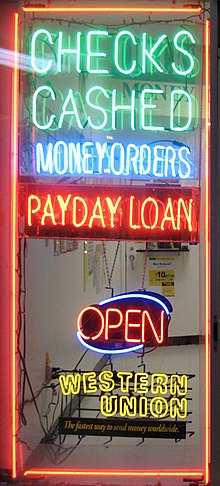The examples and perspective in this article deal primarily with the United States and do not represent a worldwide view of the subject. (August 2021) |
| Part of a series on |
| Economics |
|---|
 |

A cost of poverty, also known as a ghetto tax,[1] a poverty premium,[2] a cost of being poor, or the poor pay more,[3] is the phenomenon of people with lower incomes, particularly those living in low-income areas, incurring higher expenses, paying more not only in terms of money, but also in time, health, and opportunity costs.[4][5][6] "Costs of poverty" can also refer to the costs to the broader society in which poverty exists.[7][8]
- ^ "The Hidden Costs of Poverty". The Billfold. 2018-10-19. Retrieved 2021-02-02.
- ^ Russell, Lucie; Packman, Carl (2019-04-24). "The poverty premium". Centre for Excellence in Community Investment. Archived from the original on 2023-03-15. Retrieved 2023-06-20.
- ^ Kaplan, George A. (September 2009). "The Poor Pay More — Poverty's High Cost to Health" (PDF). University of Michigan.
- ^ Eckholm, Erik (19 July 2006). "Study Documents 'Ghetto Tax' Being Paid by the Urban Poor". The New York Times. Retrieved 14 August 2011.
- ^ Talukdar, Debabrata (2008). "Cost of Being Poor: Retail Price and Consumer Price Search Differences across Inner-City and Suburban Neighborhoods". Journal of Consumer Research. 35 (3): 457–471. doi:10.1086/589563. JSTOR 589563.
- ^ Cite error: The named reference
:1was invoked but never defined (see the help page). - ^ Holzer, Harry J.; Schanzenbach, Diane Whitmore; Duncan, Greg J.; Ludwig, Jens (24 January 2007). "The Economic Costs of Poverty". Center for American Progress. Retrieved 2021-02-03.
- ^ "Costs of Poverty Fact Sheet". Poor People's Campaign. 2020-06-09. Retrieved 2021-02-02.